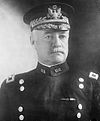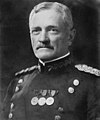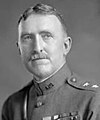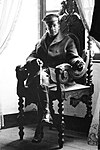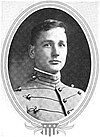| Name
|
Class year
|
Notability
|
References
|
| Tasker H. Bliss
|
1875
|
General; Spanish–American War; division commander in Philippine–American War; Chief of Staff of the United States Army (1917–1918); American representative Supreme War Council
|
[1]
|
| Eli D. Hoyle
|
1875
|
Brigadier General; father of Major General Rene Edward De Russy Hoyle; grandfather-in-law of Brigadier General Willard Ames Holbrook, Jr.; son-in-law of Brigadier General René Edward De Russy
|
[2]
|
| Hugh L. Scott
|
1876
|
Major General; Indian Wars; Superintendent of the United States Military Academy; Chief of Staff; U.S. Secretary of War; the Navy vessel USS Hugh L. Scott (AP-43) was named for him
|
[3]
|
| Eben Swift
|
1876
|
Major General; Spanish–American War, Pancho Villa Expedition; commander of the 82nd Division; Director of the United States Army War College; commander of Camp Gordon; commander of U.S. Forces in Italy; father of Major General Innis P. Swift; father-in-law of Brigadier General Evan Harris Humphrey; son-in-law of Brigadier General Innis N. Palmer; Camp Swift, Texas is named for him
|
[4]
|
| Hunter Liggett
|
1879
|
Lieutenant General; Indian Wars; Spanish–American War; Philippine–American War; in 1914 predicted that an invasion of the Philippines would occur through Lingayen Gulf, which occurred twice in World War II; division and corps commander in World War I
|
[5]
|
| Benjamin Alvord, Jr.
|
1880
|
Brigadier General; Adjutant General of the American Expeditionary Force; son of Brigadier General Benjamin Alvord
|
[6]
|
| Richard Whitehead Young
|
1882
|
Brigadier General; Philippine–American War; brigade commander; Justice of the Philippines Supreme Court; grandson of Utah Territory Governor Brigham Young
|
[7]
|
| John Wilson Ruckman
|
1883
|
Major General; inventor of artillery devices; commander of Fort Baker and Fort Mills; commander of the Southeastern Department (Aug 1917) Southern Department (Sept 1917) and the Northeastern Department (May 1918)
|
[8]
|
| Edwin Burr Babbitt
|
1884
|
Major General; Meuse-Argonne Offensive, Battle of Saint-Mihiel; recipient of the Army Distinguished Service Medal
|
[9]
|
| Robert Lee Bullard
|
1885
|
Lieutenant General; Spanish–American War; Philippine–American War; Battle of Cantigny; commander of the 1st Infantry Division; commander of the First United States Army and Second United States Army; President of the National Security League
|
[10]
|
| Willard Ames Holbrook
|
1885
|
Major General; Spanish–American War; commander of the 165th Infantry Brigade; commander of the 9th Infantry Division; Chief of the U.S. Cavalry; recipient of the Army Distinguished Service Medal; father of Brigadier General Willard Ames Holbrook, Jr.; brother of Major General Lucius Roy Holbrook; son-in-law of Major General David S. Stanley
|
[11]
|
| Mason Patrick
|
1886
|
Major General; Chief Engineer of Lines of Communication, Director of Construction and Forestry, and Chief of the Air Service of the American Expeditionary Forces; Patrick Space Force Base is named for him; the Navy vessel USS General M. M. Patrick (AP-150) was named for him
|
[12]
|
| John J. Pershing
|
1886
|
General of the Armies; Spanish–American War; Philippine–American War; Moro Rebellion; commander of 8th Regiment in the Pancho Villa Expedition; led the American Expeditionary Force in World War I
|
[13]
|
| Charles S. Farnsworth
|
1887
|
Major General; Spanish–American War, Philippine–American War; Battle of Saint-Mihiel; commander of the 37th Infantry Division; founder of Fort William McKinley; founder and commandant of the United States Army Infantry School; the Gen. Charles S. Farnsworth County Park in Altadena, California is named for him
|
[14]
|
| Robert Lee Howze
|
1888
|
Major General; American Indian Wars, Spanish–American War, Philippine–American War; Meuse-Argonne Offensive; commander of the 1st Cavalry Division; commander of the Third United States Army; commander of the 3rd Infantry Division and 38th Infantry Division; recipient of the Medal of Honor and the Army Distinguished Service Medal; father of General Hamilton H. Howze; Camp Howze and the USS General R. L. Howze (AP-134) were named for him
|
[15]
|
| Peyton C. March
|
1888
|
General; Spanish–American War, Philippine–American War, Russian Civil War; commander of 1st Artillery Brigade; Chief of Staff of the United States Army (1918–1921); father of Second Lieutenant Peyton C. March, Jr.
|
[16]
|
| Charles Symmonds
|
1888
|
Brigadier General; Spanish–American War; brigade commander; commander of Fort Bliss; recipient of the Army Distinguished Service Medal
|
[17]
|
| William G. Haan
|
1889
|
Major General; Spanish–American War, Philippine–American War; Third Battle of the Aisne, Second Battle of the Marne, Meuse-Argonne Offensive; commander of the 57th Field Artillery Brigade; the Navy vessel USS General W. G. Haan (AP-158) was named for him
|
[18]
|
| John L. Hines
|
1891
|
Major General; Spanish–American War; Philippine–American War; Pancho Villa Expedition; brigade and division commander in World War I; Chief of Staff of the United States Army (1924–1926)
|
[19]
|
| Lutz Wahl
|
1891
|
Major General; brigade commander; Adjutant General of the U.S. Army (1927–1928)
|
[20]
|
| Lucius Roy Holbrook
|
1896
|
Major General; Philippine–American War; Meuse-Argonne Offensive; commandant of the Command and General Staff College; brigade commander in the 1st Infantry Division; commander of Camp/Fort Bragg; commander of Fort Douglas and Fort Hamilton; commander of Camp Stotsenburg; commander of the 1st Infantry Division; commander of the Philippine Department
|
[21]
|
| Sherwood Cheney
|
1897
|
Brigadier General; commander, US Army Corps of Engineers; director, Army Transport Service (1919); recipient of the Army Distinguished Service Medal
|
[22]
|
| Fox Conner
|
1898
|
Major General; Chief of Operations of the American Expeditionary Force; commander of the First United States Army
|
[23]
|
| Amos Fries
|
1898
|
Major General; Philippine–American War; commander of the 1st Gas Regiment; Chief of the Chemical Warfare Service
|
[24]
|
| Guy Henry
|
1898
|
Major General; Spanish–American War, Philippine–American War, World War II; commander of the 3rd Cavalry Regiment; recipient of two Army Distinguished Service Medals and the Silver Star; son of Brigadier General, Medal of Honor recipient, and Puerto Rico Governor Guy Vernor Henry
|
[25]
|
| Manus MacCloskey
|
1898
|
Brigadier General; Spanish–American War; Battle of Verdun, Battle of Château-Thierry (1918), Battle of Belleau Wood, Battle of Soissons (1918); commander of the 12th Field Artillery Regiment; recipient of the Distinguished Service Medal and the Silver Star; father of Brigadier General Monro MacCloskey
|
[26]
|
| Stanley Dunbar Embick
|
1899
|
Lieutenant General; Spanish–American War, World War II; recipient of two Army Distinguished Service Medals; father-in-law of General Albert Coady Wedemeyer
|
[27]
|
| Clement A. Trott
|
1899
|
Major General; Chief of Staff of the 5th Infantry Division; commander of the 6th Infantry Division; recipient of the Army Distinguished Service Medal
|
[28]
|
| Ernest Dichmann Peek
|
1901
|
Major General; Supervisor of the building of Lock and Dam No. 1, Mississippi River; brigade commander; recipient of the Silver Star and the Army Distinguished Service Medal
|
[29]
|
| Emory Jenison Pike
|
1901
|
Lieutenant Colonel; recipient of the Medal of Honor (MOH) for actions in combat organizing and leading units during heavy shelling despite being mortally wounded; only Academy alumnus to receive the MOH during World War I
|
[30][31]
|
| Hugh S. Johnson
|
1903
|
Brigadier General; lawyer in Judge Advocate General's Corps; instrumental in implementing the Selective Service Act of 1917; Deputy Provost Marshal General (1971-1918); Director of the Purchase and Supply Branch of the General Staff (1918); commander of 15th Infantry Brigade; Director of the National Recovery Administration; named Time Person of the Year in 1933
|
[32]
|
| Douglas MacArthur
|
1903
|
General of the Army, Field Marshal in the Philippine Army; United States occupation of Veracruz; Second Battle of the Marne, Battle of Saint-Mihiel, Meuse-Argonne Offensive during World War I; commander of the 42nd Infantry Division; Superintendent of the United States Military Academy (1919–1922); brigade commander in the Philippine Division; commander of the Philippine Department; Chief of Staff of the United States Army (1930–1935); recipient of the Medal of Honor for actions during the Battle of Bataan, commander of the South West Pacific Area during World War II; Supreme Commander of the Allied Powers during the Occupation of Japan; Korean War; grandson of Wisconsin Governor Arthur MacArthur, Sr.; son of Lieutenant General and Medal of Honor recipient Arthur MacArthur, Jr.
|
[33]
|
| Julian Larcombe Schley
|
1903
|
Major General; Battle of Saint-Mihiel and Meuse-Argonne Offensive; Governor of the Panama Canal Zone; Chief of Engineers; recipient of the Army Distinguished Service Medal
|
[34]
|
| Henry Conger Pratt
|
1904
|
Major General; World War II; aide to William Howard Taft; commander of Brooks Field, Kelly Field, and Mitchel Field; Commandant of the Air Corps Tactical School; commander of the Philippine Division; commander of Fort William McKinley; commander of the Southern Defense Command and Western Defense Command; recipient of the Army Distinguished Service Medal
|
[35]
|
| Joseph Stilwell
|
1904
|
General; described Academy hazing as "hell"; U.S. Fourth Corps intelligence officer and helped plan the St. Mihiel offensive during World War I; commander of American forces in the China Burma India Theater in World War II
|
[36]
|
| Frank Maxwell Andrews
|
1906
|
Lieutenant General; commanded airfields in America during World War I, staff of Army of Occupation in Germany after the war; commander of the 1st Pursuit Group; commander of the General Headquarters Air Force and Panama Canal Air Force; commander of the Caribbean Defense Command; commander of the U.S. Army Forces in the Middle East; commander of U.S. forces of the European Theater of Operations; Joint Base Andrews Naval Air Facility, Andrews Air Force Base, and RAF Andrews Field are named for him
|
[37]
|
| Jonathan Mayhew Wainwright IV
|
1906
|
General; World War II; Battle of Saint-Mihiel, Meuse-Argonne Offensive; commander of the 3rd Cavalry Regiment and 1st Cavalry Regiment; commander of the Philippine Department; commander of the Fifth United States Army; recipient of the Medal of Honor, the Distinguished Service Cross, and the Army Distinguished Service Medal; Fort Wainwright is named for him
|
[38]
|
| Henry H. "Hap" Arnold
|
1907
|
General of the Army, General of the Air Force; second rated pilot in the United States Army Air Corps; executive officer of the aviation section at Army headquarters in Washington D.C. during World War I; World War II; commander of the United States Army Command and General Staff College; commander of March Field; commander of the United States Army Air Forces; founder of the RAND Corporation; Arnold Air Force Base, Arnold Engineering Development Center, and Arnold Air Society are named for him
|
[39]
|
| Robert L. Eichelberger
|
1909
|
General; Siberian Intervention; World War II; Superintendent of the United States Military Academy; commander of the I Corps; commander of the Eighth United States Army; recipient of two Distinguished Service Crosses, four Army Distinguished Service Medals, and the Navy Distinguished Service Medal
|
[40]
|
| George S. Patton
|
1909
|
General; 1912 Summer Olympics, modern pentathlon, 5th place; Pancho Villa Expedition; World War II; Battle of Saint-Mihiel, Meuse-Argonne Offensive; commander of the 1st Tank Brigade/304th Tank Brigade; commander of the 3rd Cavalry Regiment; commander of the 2nd Armored Division; commander of the II Corps; commander of the Seventh United States Army, Third United States Army, and Fifteenth United States Army during World War II; descendant of Brigadier General Hugh Mercer; father of Major General George Patton IV; Patton series of tanks were named for him
|
[41][42]
|
| Oscar Griswold
|
1910
|
Lieutenant General; World War II; Meuse-Argonne Offensive ; commander of the 29th Infantry Regiment and 4th Infantry Regiment; commander of the XIV Corps; commander of the Seventh United States Army and the Third United States Army; recipient of two Army Distinguished Service Medals, Navy Distinguished Service Medal, and two Silver Stars
|
[43]
|
| Stephen J. Chamberlin
|
1912
|
Lieutenant General; World War II; commander of the Fifth Army; recipient of the Navy Cross, the Army Distinguished Service Medal, and the Silver Star
|
[44]
|
| Walton Walker
|
1912
|
General; World War I, Korean War; commander of the 3rd Armored Division; commander of the XX Corps; commander of the Fifth United States Army and Eighth United States Army; recipient of two Distinguished Service Crosses, two Army Distinguished Service Medals, and three Silver Stars; father of General Sam S. Walker
|
[45]
|
| Carl Andrew Spaatz
|
1914
|
General; Pancho Villa Expedition; flight instructor and fighter pilot in World War I; Eighth Air Force commander in World War II; first Chief of Staff of the United States Air Force (1947–1948)
|
[46]
|
| Omar Bradley
|
1915
|
General of the Army; stationed in America during World War I; commander of the 82nd Infantry Division and 28th Infantry Division in non-combat areas prior to being assigned to combat in Operation Torch, Normandy Landings, Operation Cobra, Battle of the Bulge, commander of the First United States Army, commander of the Twelfth United States Army Group; Korean War; first Chairman of the Joint Chiefs of Staff; Administrator of the Veterans Administration; Chairman of the NATO Military Committee; Bradley Fighting Vehicle named for him
|
[47][48]
|
| Dwight D. Eisenhower
|
1915
|
General of the Army; trained tank crews in Pennsylvania during World War I; World War II; commander of European Theater of Operations and Supreme Headquarters Allied Expeditionary Force (1942–1945); 1st Military Governor of American Occupation Zone in Germany (1945); President of Columbia University (1948–1950, 1952–1953); 1st Supreme Allied Commander Europe (1951–1952); 34th President of the United States (1953–1961)
|
[49]
|
| Luis R. Esteves
|
1915
|
Major General; first Hispanic graduate of the Academy; Pancho Villa Expedition; mayor and judge of Polvo, Mexico; commander of the 23rd Battalion, which was composed of Puerto Ricans and stationed in Panama during World War I; commander of 92nd Infantry Brigade Combat Team during World War II; founder of the Puerto Rico National Guard
|
[50]
|
| Thomas B. Larkin
|
1915
|
Lieutenant General; reconnaissance officer during Second Battle of the Marne; Tunisian campaign in World War II; Quartermaster General (1946–1949)
|
[51]
|
| Dwight Johns
|
1916
|
Brigadier General; Pancho Villa Expedition, World War II; recipient of the Army Distinguished Service Medal
|
[52]
|
| Hugh John Casey
|
1918
|
Major General; instructor and engineer company commander during World War I; Chief Engineer for General of the Army Douglas MacArthur for the South West Pacific theatre of World War II; initial designer of The Pentagon; father of Major Hugh Boyd Casey; father-in-law of Major General Frank Butner Clay
|
[53]
|
| William M. Miley
|
1918
|
Major General; World War II; commander of the 503rd Parachute Infantry Regiment; commander of the 17th Airborne Division and 11th Airborne Division; recipient of the Silver Star and two Army Distinguished Service Medals
|
[54]
|



